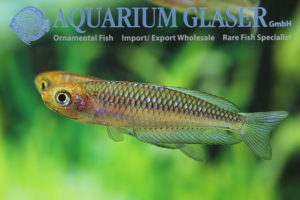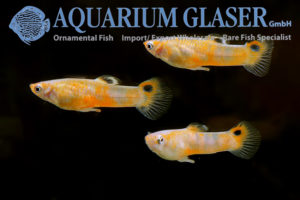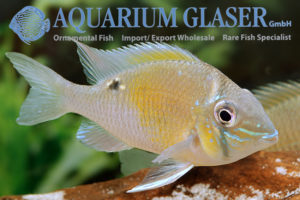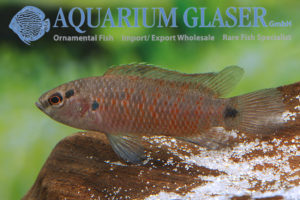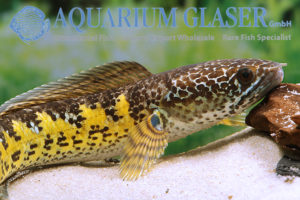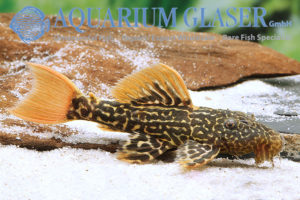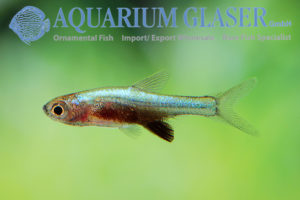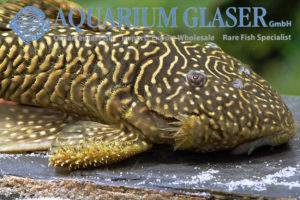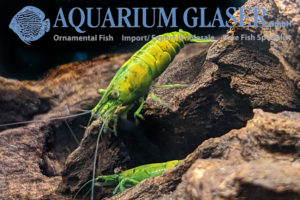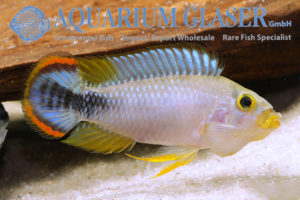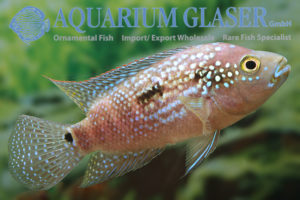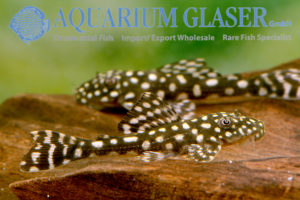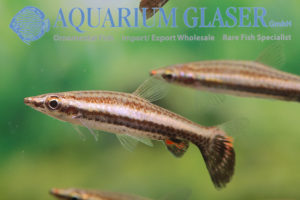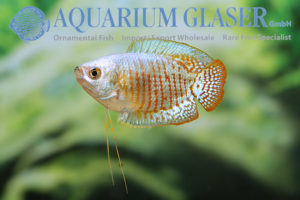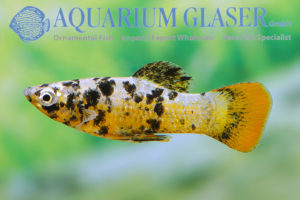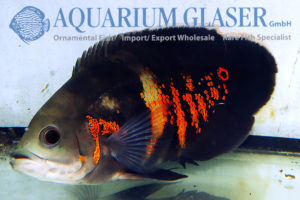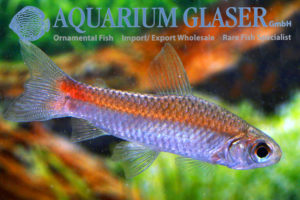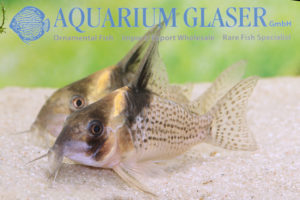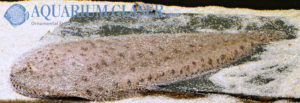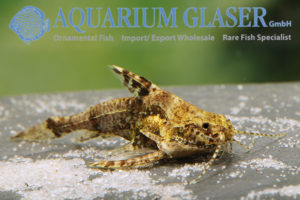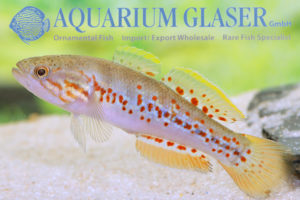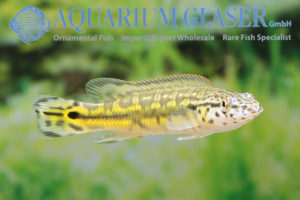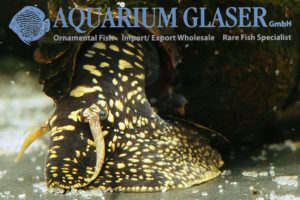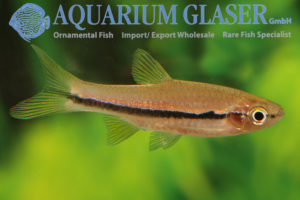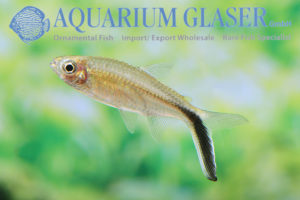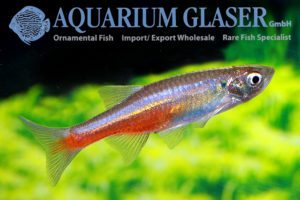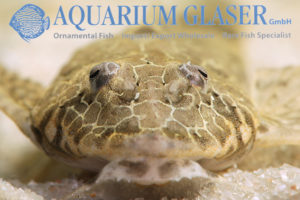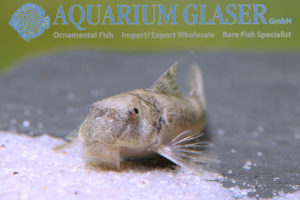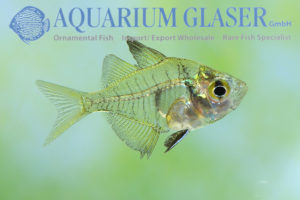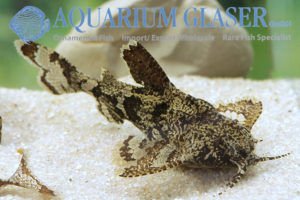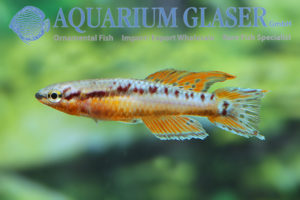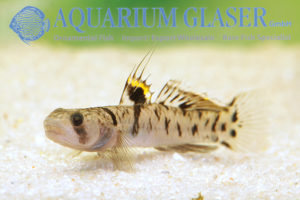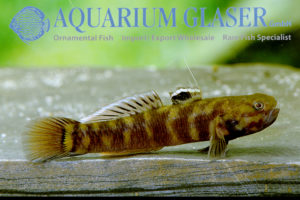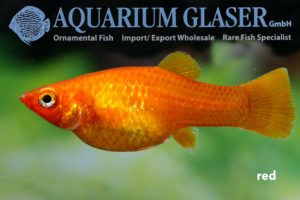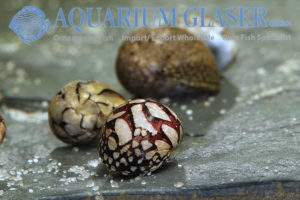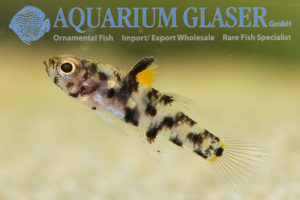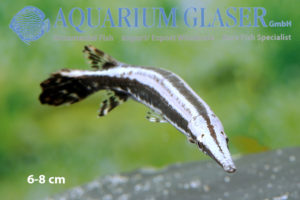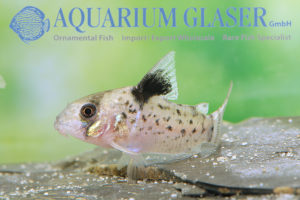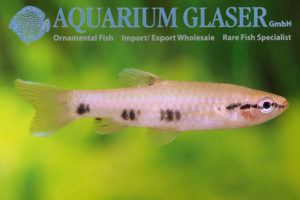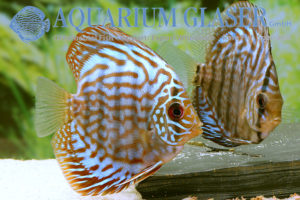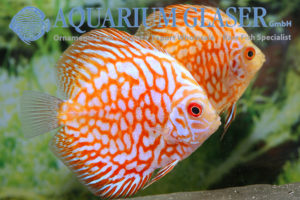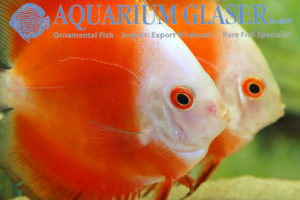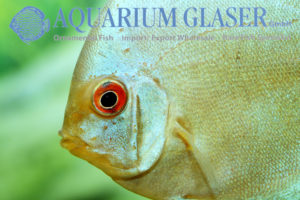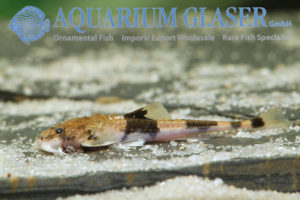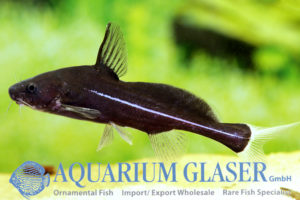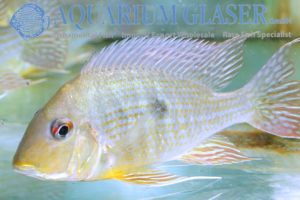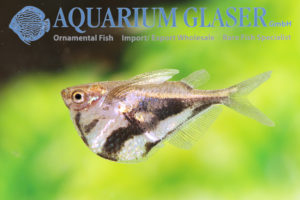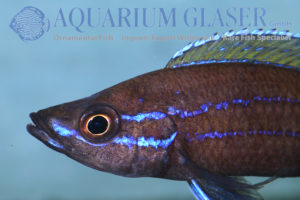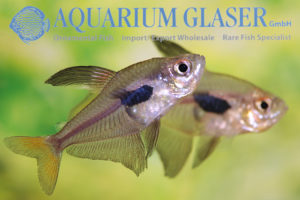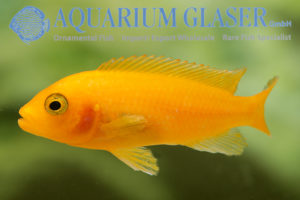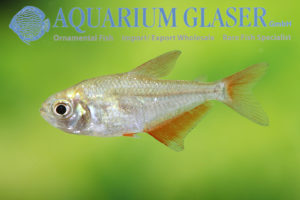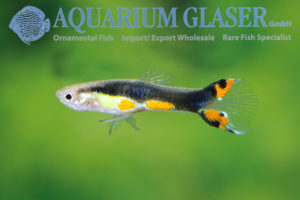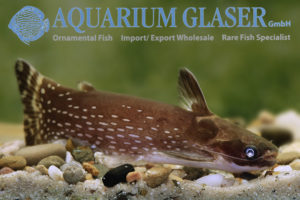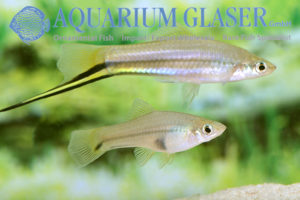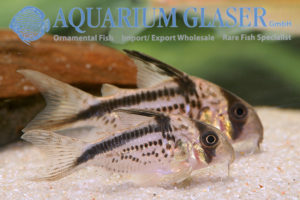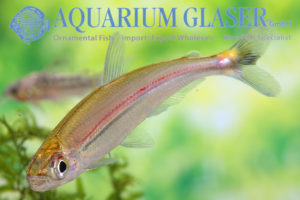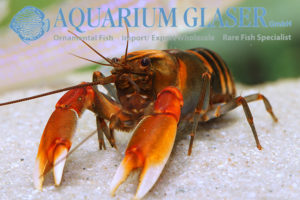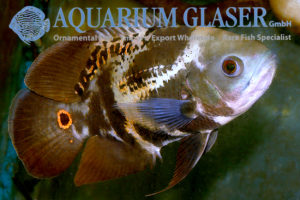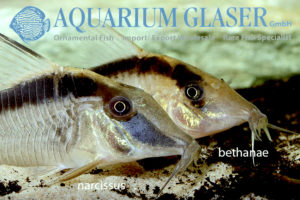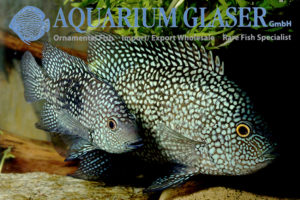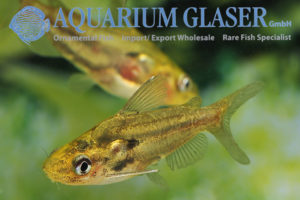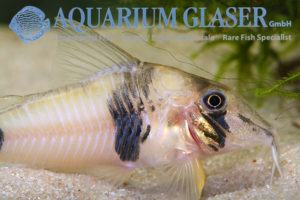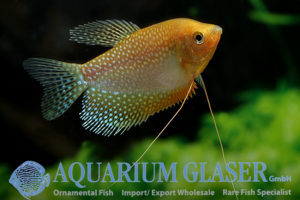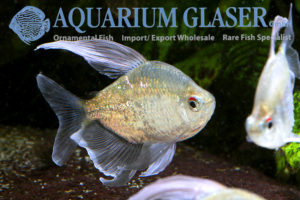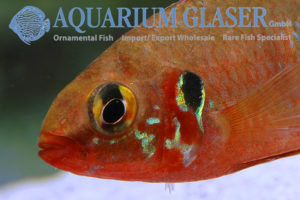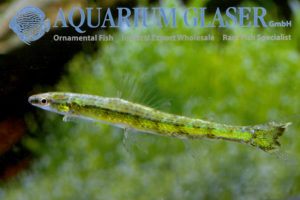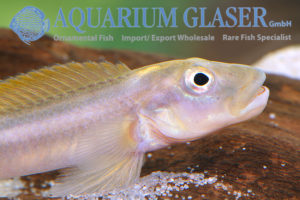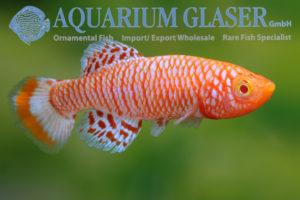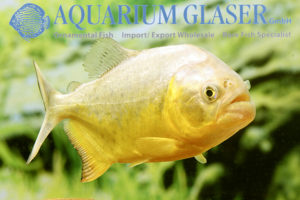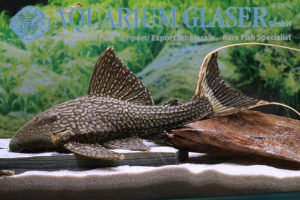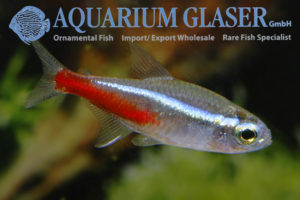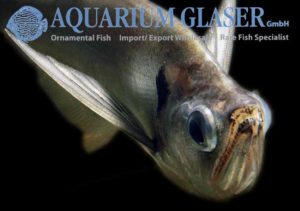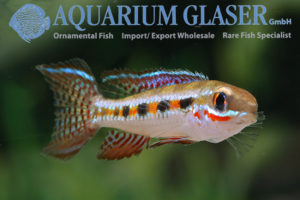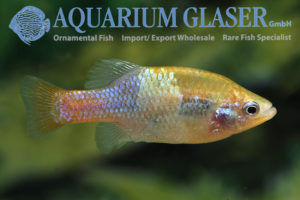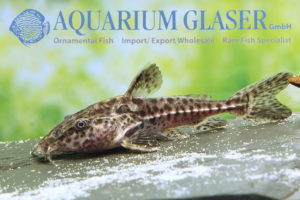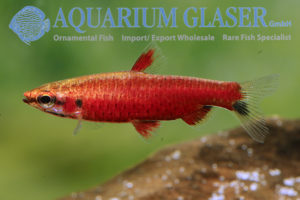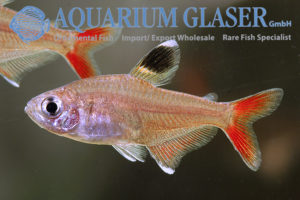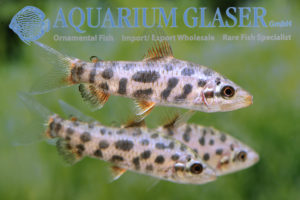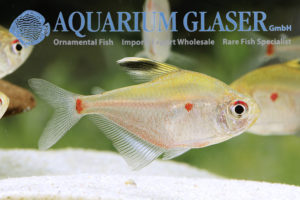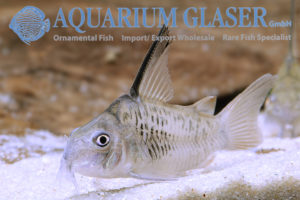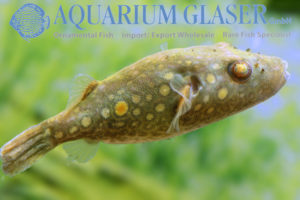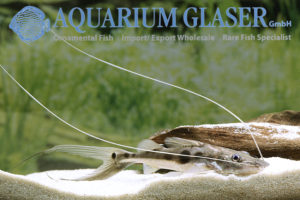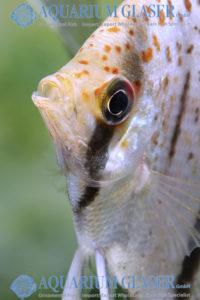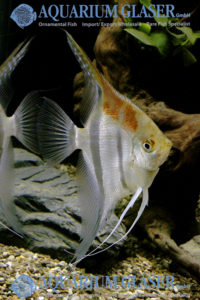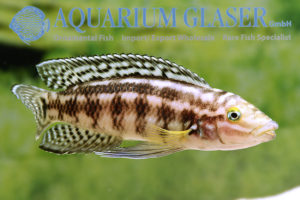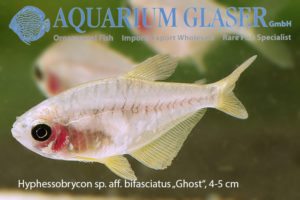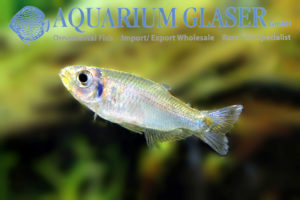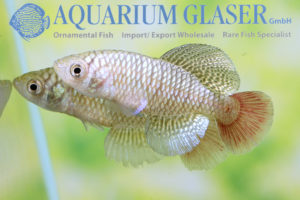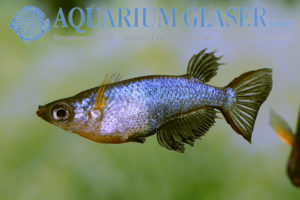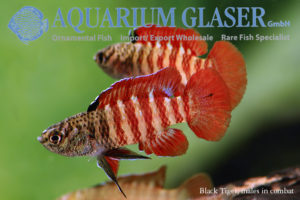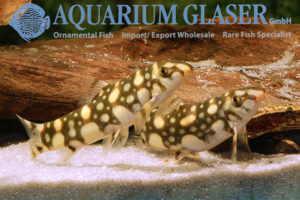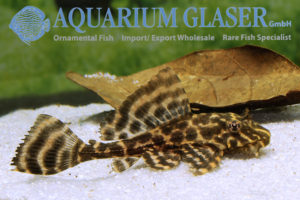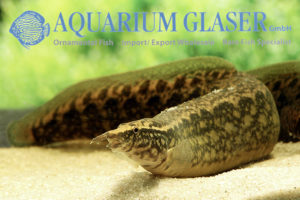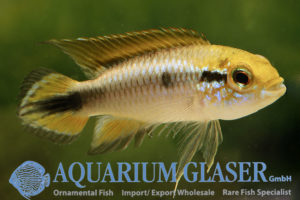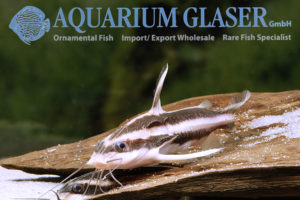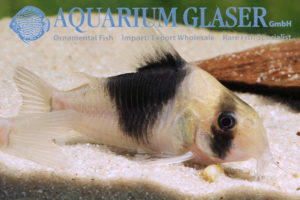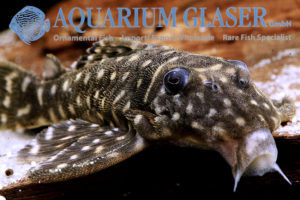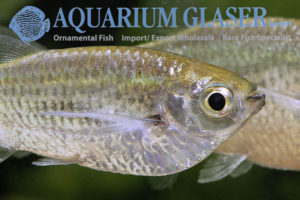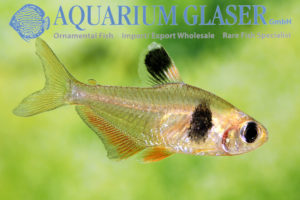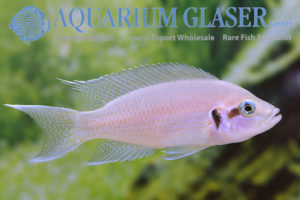An absolute rarity among the rainbowfish relatives is the ornate rainbowfish Rhadinocentrus ornatus. Within the genus Rhadinocentrus there is only one species, of which however several local variants exist. The reasons for the rarity of this fish in the hobby are that it is a subtropical species, so in the long run it needs certain […]
Fish Archive (3096)
-
-
Micropoecilia picta Red Surinam
At first sight the Micropoecilia species resemble the Guppy; however, they are not closely related. Nevertheless Micropoecila picta is often called “swamp guppy” in Surinam, because the species is not only very common in general, but also very common in swampy habitats. Now one could think, the care of such fish of slightly disreputable origin […]
-
Biotodoma cupido Peru
The small cichlid Biotodoma cupido – it reaches about 12-15 cm total length, but is already sexually mature at 6-8 cm – is probably the most widespread cichlid species in Amazonia. Among experts there is cheerful disagreement whether all the different looking animals are only local color variants or independent species. Be that as it […]
-
Badis pallidus
The flood of newly discovered Badis species does not stop. It is astonishing that 23 new species of these fishes have been scientifically accepted in the last 20 years and only four in the 200 years before! Badis pallidus was only described in 2019; it belongs to the immediate relationship of Badis badis and cannot […]
-
Channa aurantimaculata WILD
We have the probably most beautiful of all snakeheads once again available in limited numbers. This species grows up to 50 cm long in the aquarium, but normally they reach only 20-25 cm in the wild; our currently stocked fish are 14-18 cm long. The species is endemic (i.e. only found there) in northern India. […]
-
Pseudacanthicus sp. L600
We have received fantastic leopard cactus plecos L600. They are german bred ones. One specimen is as beautiful and flawless as the other! We are extremely enthusiastic about the quality of the animals. They are currently 6-8 cm long. For our customers: the fish have code 26480-L 600-2 on our stocklist. Please note that we […]
-
Sundadanio cf. axelrodi Blue ( = Rasbora sp. aff. axelrodi BLUE)
The tiny dwarfs of the genus Sundadanio were listed in the genus Rasbora until 1999. At that time only one species was known, namely S. axelrodi. Later other species were imported. They were still nameless, but clearly differed in color. Thus, there were blue, green and red Sundadanio. In 2011 the genus was revised and […]
-
Parancistrus sp. Rio Araguaia L56n / LDA46
The genus Parancistrus includes only two scientifically accepted species, the Golden Parancistrus (P. aurantiacus), which was erroneously also assigned L-number 56 (this is incorrect) and P. nudiventris, which was assigned L-numbers 31 and 176; this is a black catfish with very fine white spots. In addition, we know L258 from Rio Iriri, a black catfish […]
-
Neocaridina denticulata Hulk orange
The Hulk is a comic character from the Marvel universe, a strong, green colored fellow with high destructive potential. We assume that the new dwarf shrimp Neocaridina denticulata Hulk orange, which we could now exclusively import from Taiwan for the first time, is called Hulk because of its green main coloration, because you can hardly […]
-
Apistogramma panduro
In Apistogramma panduro from Peru (drainage of the Rio Ucayali, east of Jenaro Herrera) the females are absolutely emaciated. They are at least as beautiful as the males, if not more so; they fight as if they were males, and they show marked polychromatism. Polychromatism, or multicolorism, is when animals are individually, not species-specifically, differently […]
-
Rocio octofasciata
The beautiful cichlid Rocio octofasciata from Mexico is still known by many older people as Cichlasoma biocellatum. But all over the world young and old know him also under the popular name “Jack Dempsey”, although you have to be quite old to have experienced this legendary heavyweight boxer still in his active time: Jack Dempsey’s […]
-
Hypostomus sertanejo
For the first time we can offer this very nice Hypostomus from the Rio Jaguaribe (Cerea State, Brazil). It is a species that was described scientifically only in 2017, although 19 specimens of this species were found in the scientific collection of the Academy of Natural Sciences of Philadelphia, U.S.A., which had been collected and […]
-
Nannostomus eques Peru
The tetras of the genus Nannostomus, called pencil fish because of their somewhat stiff swimming style reminiscent of traveling zeppelins, have been among the most popular ornamental fish for decades. They are very beautiful, usually peaceful and remain small. Three species swim at an angle with their heads up: Nannostomus eques, N. britzkii and N. […]
-
Colisa lalia now Trichogaster fasciata?!
For almost 20 years, ichthyologists have disagreed on which rule of the International Rules of Zoological Nomenclature is more important for the gouramis of South and Southeast Asia: the prime directive, according to which everything else must be subordinated to the stability and universal applicability of scientific names, or the various rules that regulate which […]
-
Poecilia (Mollienesia) sphenops Marble Ancient
The livebearers are the backbone of aquaristics. The hobby would be unimaginable without Guppy, Platy, Molly and Co. We notice two trends in the breeding of these fish: one deals with the wild forms, which were very rare or not available at all in the trade; and the other develops new, colorful breeding forms, but […]
-
Astronotus sp. NEW ZEBRA/Tapajos
We have received an incredibly beautiful pair of wild caught Oscars from the Rio Tapajos. At least the male absolutely competes with the breeding form “Red Tiger Oskar” in color, but as we said, they are wild-caught! The sexes are difficult to distinguish externally in Astronotus, but the striking color difference and the expression of […]
-
Curimatopsis evelynae
The tetras of the genus Curimatopsis are widely distributed in South America. The prettiest species is C. evelynae. Nevertheless, this attractive fish has hardly found its way into aquariums so far. C. evelynae grows to a maximum length of 4 cm. The males can be recognized by their clearly higher caudal peduncle, furthermore the females […]
-
Corydoras cf. brevirostris CW 27 Highfin
We received a limited number of this extraordinary Corydoras from Colombia. The overall appearance is very much alike Corydoras brevirostris (formerly known as Corydoras melanistius brevirostris), but CW 27 has a much much higher dorsal fin and the “glowspot” on the nape is much brighter. For our customers: the animals have code 224954 on our […]
-
Apionichthys nattereri
When we think of flatfishes like flounders, plaice, butts and tongues, we actually think of the sea and edible fishes. However, it is little known that several species are also purely freshwater dwellers. Among the Achiridae (American sole) in South America, for example, 26 species are known from freshwater, but many of them are euryhaline, […]
-
Physopyxis lyra
Although this dwarf among the thorny catfishes – it only grows to about 3 cm in length – was scientifically described as early as 1872, it was completely unknown to aquarists until a few years ago. This is a pity, because they are droll, very interesting small catfishes, which are also suitable for small and […]
-
Mogurnda mogurnda
The Australian northern trout gudgeon (Mogurnda mogurnda) belongs to the very few fishes of the fifth continent, which became native already before the 2nd world war in the aquaria. They are very beautifully colored animals, which in contrast to many other gobies are also relatively easy to breed. Unfortunately, the animals are only of limited […]
-
Crenicichla sp. Tapajos I / Cobra Pike
The Rio Tapajós in Brazil is a more than 800 km long tributary of the Amazon. It is also the largest tributary of the Amazon River and flows to its right side when viewed downstream. It is not surprising that the great Tapajós River contains numerous endemic species, i.e. species that only occur there and […]
-
Tylomelania towutensis
The snails of the Malili Lakes on Sulawesi (formerly: Celebes) belonging to the family Pachychildae are great animals to keep for their own sake and not just as useful algae and debris eaters, like many other snails. All Tylomelania species of the region have in common that they occur in warm (around 30°C), soft and […]
-
Rasbora einthovenii
A typical companion fish of harlequin barbs (Trigonostigma), chocolate gouramis (Sphaerichthys) and other blackwater fish is Rasbora einthovenii. The species is unfortunately very rarely imported, although it has a large range. It is found on the large Sunda islands of Sumatra and Borneo, on the Malay Peninsula and in southern Thailand in suitable biotopes. Usually […]
-
Thayeria obliqua
Unfortunately the beautiful penguin tetra, Thayeria obliqua, from the upper Amazon is offered only very rarely, in contrast to its cousin T. boehlkei, which can always be found in the trade. In the trade are only offsprings of T. boehlkei; it originates from the Rio Xingu drainage in Brazil. A third species, T. ifati from […]
-
Devario sondhii
This beautiful danio comes from Burma. It looks like the big brother of Microrasbora rubenscens. Males become wonderful red. Temperature: 18-28°, the water should preferably be rather hard and alcalic than soft and acidic, the fish is a peaceful schooling fish that attains a maximum length of around 5-7 cm. For our customers: the fish […]
-
Rineloricaria teffeana
The small remaining whiptail catfishes of the genus Rineloricaria enjoy great popularity among aquarists. They have a whimsical appearance, are peaceful, have no high space requirements and can usually be bred quite well. Some species have even really fancy pattern. The most beautiful is certainly R. teffeana. It has no bright colors, but a really […]
-
Parotocinclus jumbo LDA25, now available as German bred!
The cute Parotocinclus jumbo, also known as Pitbull Pleco or LDA25, is a very popular aquarium fish. Unfortunately imports take place only very irregularly and can hardly be planned. Therefore we are happy to be able to offer this nice little fish as offspring now. More information about the species can be found here: https://www.aquariumglaser.de/en/fish-archives/lda25-parotocinclus-jumbo-2/ […]
-
Parambassis lala Bred
The dwarf glass perch, Parambassis lala, is widely distributed in South Asia; it can be found in India, Burma and Nepal. In the past this dwarf, which never grows larger than 2-3 cm, was mistaken for the juvenile of other species, which is why completely wrong size data (up to 8 cm) and also completely […]
-
Hara hara/Erethistes pusillus
In India live two species of moth catfishes, which are practically impossible to distinguish in living condition. They are nevertheless sometimes even assigned to two different genera: Hara and Erethistes. The difference between the two genera lies in the structure of the vertebral body, that is, of something invisible in the living animal; according to […]
-
Aphyosemion (Chromaphyosemion) bivittatum “Funge”.
The Funge is a river or, rather, estuary in southeastern Cameroon in the district of Ndian. The Funge is less than 40 km long and is part of a system of coastal marshlands whose best known outlet is the Rio del Rey. This in turn is in contact with the Cross River drainage, which forms […]
-
Mugilogobius chulae
After many years we have once again imported the cute brackish water goby Mugilogobius chulae. The species grows only about 4 cm long and lives in brackish water regions and in fresh waters where the tidal influence is noticeable. Our animals come from Indonesia, but the species is widely distributed in the western Pacific region […]
-
Mugilogobius mertoni
The genus Mugilogobius comprises 33 species. The determination of living specimens is often uncertain, because the anatomical features (especially certain sensory pits), which show quite clearly in formalin preserved animals, are not recognizable in the living fish. Since there is hardly any picture material of surely determined animals, doubts often remain. Since the species reproduce […]
-
Poecilia (Mollienesia) sphenops RED
The breeders in Southeast Asia have realized a new color variation of the good old Black Molly, which they call “Red”. This is not a solid red fish, like for example a red swordtail, but the breeding form “Red” of the Molly has red spots in different intensity on the scales. When viewed from above, […]
-
Vitta virginea ( = Neritina virginea)
The Nerites, also known as racing snails (family Neritidae), are distributed worldwide in warm and temperate zones. They have an operculum at the foot that allows them to close the shell completely, a cup-shaped shell, and they are often strikingly brightly colored. Many tropical species colonize uppermost shore areas and can live in both seawater […]
-
Pandaka rouxi
The dwarf gobies of the genus Pandaka are closely related to the bumble bee gobies (Brachygobius), but still much smaller. The species Pandaka pygmea was even considered the smallest vertebrate on earth for a long time, but it has since been outranked. The species Pandaka rouxi also usually grows to only 10-12 mm in length, […]
-
Lepisosteus oculatus “Metallic“
We have already reported about the Spotted Gar (Lepisosteus oculatus), see https://www.aquariumglaser.de/en/fish-archives/lepisosteus-oculatus-2/. Now we have received small gars from Indonesia, which correspond in all characteristics to L. oculatus, but show a very striking silver luster. The smaller ones (6-8 cm) have a quite dark basic coloration, which brightens up clearly with somewhat larger animals (11-14 […]
-
Corydoras leucomelas
Corydoras leucomelas belongs to the frequently imported species of its genus. Typical characteristics of the round-nosed species are a strongly pronounced eye band, the coloration of the dorsal fin in connection with the black dorsal spot located at the beginning of the dorsal fin, a vertical black band at the end of the caudal peduncle […]
-
Pyrrhulina spilota
The tetras belonging to the genus Pyrrhulina combine the advantages of two basic groups of ornamental fish. The first group are the schooling species that are always visible and swim merely in the open water: tetras and barbs. The second group has a fascinating behaviour and takes care for the brood: the cichlids and the […]
-
Symphysodon “Super Red Turqoise”.
The Red Turquoise lines were among the first breeding forms of the Discus Cichlid, developed in the 1980s. Aquaristics had reached the point where wild-caught Brown/Blue Discus could be considered “cracked”. So one mastered their successful acclimation and breeding. Since wild-caught discus turn out very inconsistently – between simply brown and completely blue streaked animals […]
-
Symphysodon “Pidgeon Blood Panda”
The “Pidgeon Blood” discus, which appeared in the early 1990s as a mutation in Asian discus breeding, revolutionized discus breeding. It combined two characteristics that discus breeders had previously only dreamed of: an early coloration, i.e. already 5-7 cm long juveniles look essentially like adult fish in terms of color. And a second advantage of […]
-
Symphysodon “Marlboro Red”
The color red is the dream color of many animal breeders. Red canaries, red swordtails, red guppies, red angelfish – wherever this was genetically possible, it was realized. With polychromatic fish species, e.g. with Apistogramma, where in nature always several color variants occur together, the red ones were preferred in breeding. And with the discus? […]
-
Symphysodon “Blue Diamond“
The Asian discus cultivars enjoy great popularity, because on the one hand they color very early (wild forms all look similarly unspectacular in 5-7 cm length) and on the other hand they are not very shy, so they can be presented well even in unfamiliar surroundings. Of the solid blue discus, the Blue Diamond, which […]
-
Hoplomyzon sexpapilostoma
Within the banjo catfish family (Aspredinidae), there is a group of dwarfish small species (called the tribus Hoplomyzontini) divided into four genera: Ernstichthys, Hoplomyzon, Dupouyichthys and Micromyzon. They grow only 2-3 cm long. In nature they live buried in fine sand (at least during the day). Most species prefer the deepest channels of medium to […]
-
Bagrichthys macracanthus
Bagrichthys macracanthus is a very interesting catfish from Southeast Asia (East Sumatra). This catfish reaches a maximum length of about 20 cm. In nature it lives in calm river sections. Among themselves, especially the males are quite incompatible, in pairs or in groups of a male with a surplus of females maintained, however, the species […]
-
Geophagus sp. “Caqueta”
From the Colombian province of Caquetá we occasionally receive a magnificent Geophagus of the surinamensis group, which is obviously a scientifically not yet described species. Three color characteristics are used for the identification of Geophagus of this complex relationship: 1. the shape, position and size of the lateral spot in relation to the eye, 2. […]
-
Carnegiella strigata-vesca
The marble hatchetfish (Carnegiella strigata) is the ideal aquarium fish. It remains small (4 cm), is peaceful and has an interesting coloration. The species is widely distributed in South America (Brazil, Ecuador, Bolivia, Colombia, Guyana, Peru and Suriname) and common. That is why it is almost always found in the offer of the ornamental fish […]
-
Paracyprichromis nigripinnis “Blue Neon”
Cyprichromis and Paracyprichromis are very special mouthbrooding cichlids from Lake Tanganyika. They live in sometimes huge schools and feed on small animals that they pick from the free water column. To attract the attention of females, the males can be very colorful. They do not occupy actual territories. The females, on the other hand, are […]
-
Hyphessobrycon epicharis
Since the first scientific description of Hyphessobrycon epicharis in 1997, this species is on the dream list of many tetra enthusiasts. Unique feature of this Rosy tetra is the shape of the shoulder spot, which distinguishes it from all other species. The specimens on which the first description was based came from the upper reaches […]
-
Maylandia estherae Red/Red
One of the most popular, because most colorful cichlids of Lake Malawi is the O-form of Maylandia estherae (synonym: Metriaclima e.). “O” stands for “orange.” As with many other species of Lake Malawi, several color forms occur within the same population of M. estherae in the wild. In the “normal” color form of M. estherae, […]
-
Gymnocorymbus bondi (formerly: G. socolofi)
It has been a long time since we could import the last time the beautiful tetra Gymnocorymbus bondi from Colombia. Very small animals remind strikingly of the Yellow Tetra (Hyphessobrycon bifasciatus), but with increasing growth the shape changes more and more to the one known from Gymnocorymbus. Now we finally got this orangefin tetra once […]
-
Guppy Endler “Smoky Mary“
Breeders can’t get enough of creating new color combinations in Endler guppies. The latest thing is the “Smoky Mary”, an Endler in which the entire back appears covered in smoke, which intesivates to a deep black during courtship. Even though we don’t know the breeding way: the females of Smoky Mary are normally light colored, […]
-
Tatia intermedia
From Peru a larger number of Tatia reached us thanks to this import we can now solve an more than 10 year old puzzle. In 2011 we received from this country monochrome Tatia, which could not be assigned to any known species (https://www.aquariumglaser.de/en/fish-archives/tatia_sp_tahuayo_river_en/). Now it is clear: it is a monochrome color variant of T. […]
-
Xiphophorus signum
This species of swordtail is only very rarely offered in the trade. At the first glimpse one may think that they are a variety of the common swortail X. hellerii, but the species X. signum is much more slender. The mark that is responsible for the scientific name (latin signum = sign) is always good […]
-
Corydoras loxozonus
This Corydoras belongs to the most attractive and at the same time easy to keep species of the large genus Corydoras. One should only consider that C. loxozonus – it originates from the Orinoco and its tributaries – likes it warm; below 24°C the temperature of the water should not sink in the long run. […]
-
Iguanodectes purusii
Four species of the peculiar lizard tetras (Iguanodectes) are imported from time to time: I. spilurus, I. adujai, I. geisleri and I. purusii. But altogether there are eight accepted species and because of the similarity of these fishes and their wide distribution it is not always so sure if the classification of the imports is […]
-
Cherax peknyi
Once again we were able to import zebra crayfish. These crayfish experienced some name changes due to the fact that the freshwater crayfishes of New Guinea were little known prior to their aquaristic discovery. The animal originally entered the trade as Cherax misolicus, but it was thought to be more likely C. papuanus. Its valid […]
-
Astronotus mikoljii
Of the seven scientifically described species of Astronotus, only two are currently recognized by most ichthyologists, namely A. crassipinnis and A. ocellatus; however, a third, A. zebra, is so distinctly different in color from the others that there is little doubt as to its validity. Now a new name has been established: the Oscar from […]
-
Corydoras narcissus and Corydoras bethanea (= C. sp. “Narcissus II”; CW6)
The changed export regulations in Brazil, which have been valid for some time, have now made it possible to import Corydoras narcissus again after a long time. Corydoras narcissus is a beautiful, relatively large armored catfish. The maximum length is given with 10 cm. The species comes from Brazil, more precisely from the drainage of […]
-
Herichthys carpinte
The Texas cichlid was successfully introduced to Germany and bred as early as 1902. In the meantime the species has undergone several name changes. In former times it was called Cichlasoma cyanoguttatum, today it is placed in the genus Herichthys and it is believed that the large spotted form as we can offer it right […]
-
Chandramara chandramara
In 1822, the most comprehensive book on the fish life of the Ganges River in India to date was published. The author was the Scottish physician Francis Hamilton, who was in the service of the East Indian Company. Hamilton had detailed drawings made of all the fish species he found in the Ganges. His draftsman […]
-
Corydoras desana
There are still Corydoras species which are imported so rarely and in such small numbers that they belong to the unfulfilled dreams of armored catfish lovers. One of the most attractive species of this group is certainly the “Tukano Longnose”, as it was first named, then it received the code CW011 and finally the species […]
-
Trichogaster leerii “Gold“
Gold forms – also called xanthorists – are quite common in fish, even in nature. Ever since the beginning of man’s records of natural phenomena, there has been talk of golden perch, carp, crucian carp, tench and pike. Of course, such mutations occur much more often in breeding than in the wild, because there such […]
-
Moenkhausia pittieri
The diamond tetra (Moenkhausia pittieri) has been in the hobby since 1933. The species lives endemically in Lake Valencia in Venezuela, so it only occurs there (including some inflows and outflows). Usually it is only in the trade as offspring, very rarely a few wild catches come in. At first sight the diamond tetra may […]
-
Hemichromis sp. ,,Ankasa”
We have received very nice offsprings of this attractive red jewel cichlid (Hemichromis). The animals are 4-6 cm long at the moment and thus just at the border to sexual maturity. Fully grown they are with about 10 cm. Then they are much more high-backed and have a splendid red coloration, which is only indicated […]
-
Ammocryptocharax elegans
There is probably no other freshwater fish that can show such a poisonous green as body coloration as the about 4-5 cm long ground tetra Ammocryptocharax elegans, which we were able to import in small numbers from the Orinoco darinage (Colombia/Venezuela). However, the animals have an extreme color change ability and if they sense danger, […]
-
Steatocranus tinanti
Unfortunately imports from the Congo are becoming more and more rare, but when they do come, they usually include humphead cichlids (Steatocranus). There are almost always three species mixed. The strongest and most high-backed of them is S. casuarius, which can be recognized by the black scale centers. It has – due to mood – […]
-
Nothobranchius rachovii ALBINO
Rachows Nothobranch (named in honor of Arthur Rachow, therefore in the common name with “w” at the end) belongs not only to the longest serving, but also to the timelessly most beautiful Killifishes in the aquarium. The orange color form of Beira is the most common in the trade, and has been continuously maintained in […]
-
Pygocentrus ternetzi
To say it right away: yes, we also know that the species P. ternetzi is currently seen by most ichthyologists as a synonym of P. nattereri. This assessment is based on the fact that the “true” Pygocentrus nattereri is the yellow-breasted species from the drainage of the Rio Paraguay (type locality of P. nattereri described […]
-
L90a Panaque bathyphilus
The large-growing, magnificent Panaque bathyphilus is very variable in coloration. We have at present quite splendid 16-20 cm long animals in stock. With this they are about half grown, as maximum length for P. bathyphilus about 60 cm are given. It goes without saying that these large fish should only be kept in large aquariums. […]
-
Paracheirodon innesi Wild
You think these neon tetras are nothing special? They are! They are wild collected ones from Peru! Although for sure 99.99% of all neon tetras traded worldwide are bred ones the species is still very common in the wild. And so every now and then they are sent to Europe as ambassadors of their kind. […]
-
Cynodon gibbus
Only very rarely this “vampire predator tetra” gets into our tanks, because this species is extremely sensitive. So we are of course especially pleased that our specimens are very stable and in good health. We received the animals from Peru. Cynodon gibbus is a predatory fish that feeds on small fish. The species is very […]
-
Dicrossus filamentosus
The checkerboard cichlid (Dicrossus filamentosus) is the most typical dwarf cichlid in the habitat of the cardinal tetra (Paracheirodon axelrodi). It is found in Brazil (Rio Negro drainage) as well as in Colombia and Venezuela (Orinoco drainage). Males have a lyre-shaped caudal fin and grow to almost 8 cm long; the caudal fin of females […]
-
Xenotoca doadrioi
In the past, this particularly pretty goodeid (Xenotoca doadrioi) was known as “Xentotoca eiseni San Marcos”. Unfortunately, the species, which was only “officially” described as a distinct species in 2016, is highly endangered. More than 50% of the originally known populations have already disappeared, with the rest showing a steady downward trend. The causes are […]
-
Oxydoras niger
With a maximum length of 1 meter Oxydoras niger belongs to the largest species of thorny catfishes. Nevertheless it is a very peaceful species and therefore quite attractive for owners of very large aquariums, show aquariums and zoos. Fully grown these fishes are uniformly black (this is exactly what the species name “niger” = black […]
-
Nannostomus sp “Super Red“
Since a few weeks pictures of bright red Nannostomus are circulating, which seem to be unnaturally colorful. However, these are actually wild forms from Peru, which are very close to or even identical with the Nannostomus rubrocaudatus (the “Purple”), which is also found there. Like the latter, the novelties have a prominent black spot in […]
-
Hyphessobrycon micropterus
Again we succeeded in importing the unfortunately very rarely offered, very attractive Hyphessobrycon micropterus from the Rio Sao Francisco in Brazil. For more information please see: https://www.aquariumglaser.de/en/fish-archives/hyphessobrycon-micropterus-2/ The pictures in this post show animals from our current stock (June 2022). For our customers: the animals have code 261853 on our stock list. Please note that […]
-
Leporinus sp. “Strawberry” Bred
So far we could import this probably most beautiful of all Leporinus only once: Leporinus sp. “Strawberry”. That was in the season 2010/2011, in which we managed two imports in small numbers. For these fishes please see https://www.aquariumglaser.de/en/fish-archives/leporinus_sp_strawberry__en/ An interesting side note: five of the fishes imported at that time we got back in top […]
-
Hyphessobrycon socolofi var. Green
Only rather rarely – every few years – and if, then always in the summer months June-July-August, we receive Hyphessobrycon socolofi from Brazil, in which the back shines conspicuously green; besides, the second cherry-red spot on the tail root is colored particularly intensively red with these animals. We have been observing this phenomenon for many […]
-
Corydoras armatus
In the last years we reported more often about Corydoras imports, which are similar to Corydoras armatus (= sp. aff. armatus or cf. armatus), but not identical. Now we received again the “real” C. armatus from Peru. The enormously high dorsal fin is really an eye-catcher. In addition it is always carried tautly upright, which […]
-
Pao abei (formerly Tetraodon abei)
This beautiful and – by Pao standards – peaceful freshwater pufferfish originates from the Mekong River basin in Laos (type locality: the Xe Bangfai River near Ban Geng Sahwang); it is considered endemic (= only occurring there) in the Xe Bangfai. In contrast to Pao turgidus, which occurs in the same river, P. abei has […]
-
Platysilurus mucosus
Predatory catfishes exude a special fascination to many a catfish lover. Unfortunately, many species simply become too large for permanent care in a normal sized home aquarium. However, there are also species that grow to only 20-30 cm in length and for which it is therefore not necessary to flood the entire basement to meet […]
-
Pterophyllum sp. “Guyana Red Dragon”.
Similar to the fact that there are several red-backed angelfish populations, there are also several red or yellow-spotted wild forms. The ancestors of Pterophyllum sp. “Guyana Red Dragon” came from the Essequibo River in Guyana. Number and intensity of dots vary individually in each fish, but all specimens we currently received (they are now 5-7 […]
-
Pterophyllum “Manacapuru redback”.
There is a lot of interest in special wild forms of the angelfish. Among the best known is the “Manacapuru Redback”, a very striking form. Because of the strong need for revision of the genus Pterophyllum, it is better not to call it “Pterophyllum scalare” scientifically, because what exactly this “real” scalare is has yet […]
-
Julidochromis marlieri
The julies (Julidochromis) belong to the most popular cichlids from Lake Tanganyika. They are very beautiful, colorful and comparatively peaceful animals. Of course, for reproduction territories are formed and defended against other fish. All Julidochromis are recommendable aquarium fish, there is a suitable species for every aquarium. The largest is J. marlieri, of which we […]
-
Hyphessobrycon sp. aff. bifasciatus “Ghost” and H. bifasciatus “Red Fin” wild
For the first time we can offer this interesting and attractive tetra novelty: Hyphessobrycon sp. aff. bifasciatus “Ghost”. The origin of this fish is not known to us. Our breeder received the parents from Vienna. When the young fish obtained with them developed strong red fins, which they lost again when growing up, the close […]
-
Tyttocharax cochui
Finally we were able to import once more one of the most charming dwarf tetras at all: Tyttocharax cochui. These very lively and absolutely peaceful blue flashes become only 1.5-2 cm long. The story how T. cochui was discovered is quite interesting.They were imported for the first time in April 1949 to Germany – as […]
-
Nothobranchius patrizii
The nothobranchs (Nothobranchius) represents with N. furzeri one of the shortest-lived vertebrates of the world. Only the marine goby Eviota sigillata tops it, with it (in nature) never an animal became older than 59 days. In the case of N. furzeri, the time between hatching from the egg and death from old age is also […]
-
Oryzias woworae
The Blue Daisy (Oryzias woworae) is known by almost every aquarist child and we have this beautiful and easy to care fish regularly in our offer. Our current stock, offspring from Indonesia, consists of particularly large animals, which color themselves splendidly almost black in the courtship display. Apparently one has successfully crossed the attractive “Black” […]
-
Dario tigris – the “Black Tiger” was scientifically described
The cute Flame Red Dwarf Badis (Dario hysginon) we have quite regularly in our stock. It originates from Burma (drainage of the Irrawaddy, Myitkyina District, Kachin State). More pictures of the species can be found here: https://www.aquariumglaser.de/fischarchiv/dario_hyginon_2__en/ Partly together with the Flame Red another dwarf badis occurs in nature, which is already mentioned in the […]
-
Botia kubotai
Some botias, among them B. kubotai, are available only seasonal and for a quite short time per year. The very beautiful species B. kubotai originates from the Salween-tributary Ataran in the border region between Burma and Thailand. It becomes around 8-10 cm long, maximum length reported so far is 13 cm. This species is one […]
-
Glyptoperichthys parnaibae
For the first time ever we can offer Glyptoperichthys parnaibae, so far known exclusively from the Rio Parnaiba in Brazil. The Rio Parnaiba is located in the northeast of Brazil and has a high proportion of endemic, i.e. only there occurring fish species, because there is no connection to other river systems. The juveniles of […]
-
Macrognathus maculatus
Spiny eels enjoy an increasing popularity. More and more aquarists are discovering that it is not always the colorful, constantly visible fish that are fun to watch, but also the more hidden fish personalities that are often only seen when feeding. Among these fish personalities are definitely the spiny eels. There are spiny eels in […]
-
Apistogramma agassizii Peru wild
The dwarf cichlid Apistogramma agassizii has a distribution area that extends through practically the entire Amazon. With many of its genus comrades it is completely different, they often occur only locally and form then also location variants. Agassiz’ dwarf cichlid has so far successfully resisted all attempts to divide it. It is true that some […]
-
Platydoras armatulus
The snarling zebra catfish – this is how Platydoras armatulus could be popularly called. However, it is actually called the striped raphael catfish. All spiny catfish can make distinct growling or croaking sounds when taken out of the water. They vibrate their whole body. Presumably this serves as a defense against enemies. But even without […]
-
Hoplisoma (formerly Corydoras) sp. CW 51
The “New Pandas” from Colombia belong to the most attractive and at the same time easy to keep and breed corydoras of the last years. There are two forms/species, CW 49 and CW 51, which differ clearly in the shape of the black saddle spot. Currently we have beautiful CW 51 in different sizes in […]
-
L129 var Hypancistrus debilittera
The small remaining, nicely marked Hypancistrus debilittera from the Rio Bita (a tributary to the Rio Meta, Colombia, Orinoco drainage) enjoys a great popularity since years. Already with 7 cm length the males become sexually active, the maximum length is given with about 12 cm. We import this species regularly. Recently we received a “Hypancistrus […]
-
Triportheus rotundatus
The strange narrow hatchetfish of the genus Triportheus belong to the flying fishes of freshwater. This is already indicated by the mighty pectoral keel with the muscles attached to it and the very long pectoral fins. The fish are predominantly silvery colored and grow to about 15 cm in length, which is why they are […]
-
Hyphessobrycon takasei
The Coffee Bean Tetra is an exceptional species within the so-called Rosy Tetras: no other species has even a hint of such a large shoulder spot. The distribution area of the species is in the lower Amazon basin, the border area between Brazil and French Guyana. There you can find the Coffee Bean Tetra in […]
-
Neolamprologus pulcher (= N. brichardi)
Whoever coined the name “Princess of Burundi” for this beautiful small cichlid: it is a brilliant name! The fish commonly known as Neolamprologus brichardi is by no means found only in Burundi, but is distributed in numerous color variants in Lake Tanganyika, which led to several scientific descriptions: Lamprologus savoryi pulcher, L. olivaceus, L. elongatus […]
- « Previous Page
- 1
- …
- 5
- 6
- 7
- 8
- 9
- …
- 31
- Next Page »





